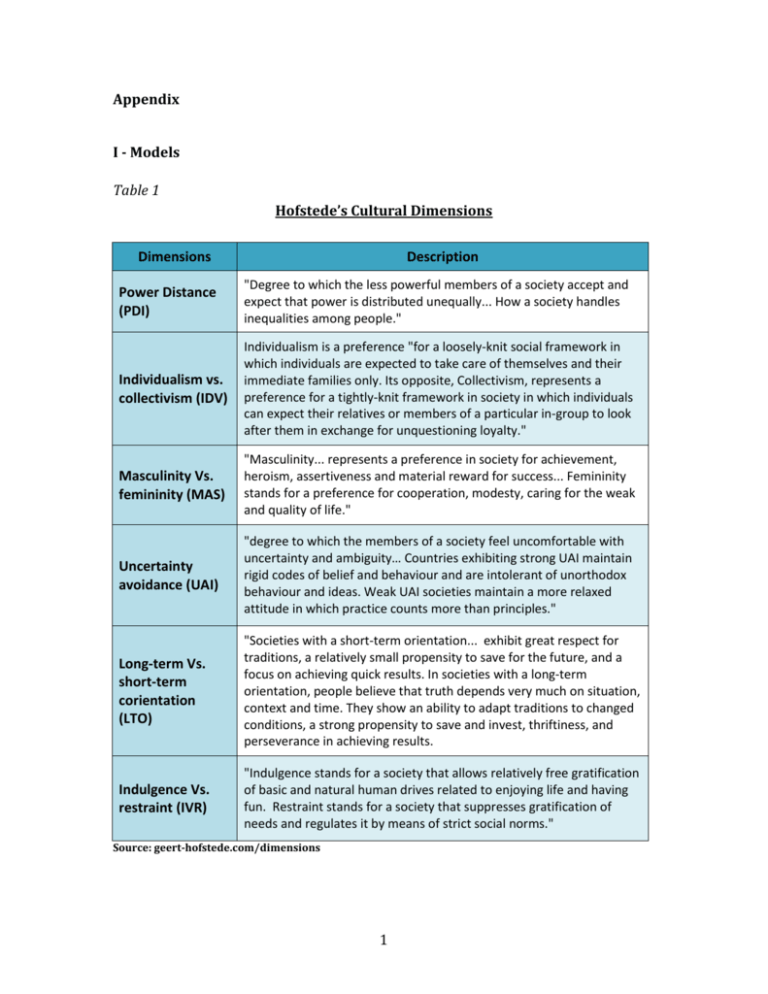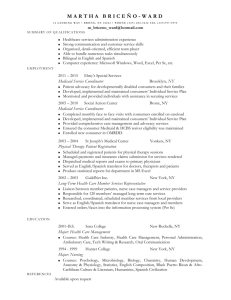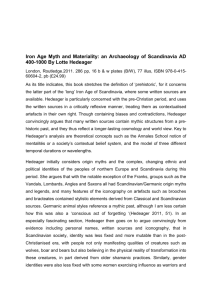Appendix
advertisement

Appendix I - Models Table 1 Hofstede’s Cultural Dimensions Dimensions Description Power Distance (PDI) "Degree to which the less powerful members of a society accept and expect that power is distributed unequally... How a society handles inequalities among people." Individualism vs. collectivism (IDV) Individualism is a preference "for a loosely-knit social framework in which individuals are expected to take care of themselves and their immediate families only. Its opposite, Collectivism, represents a preference for a tightly-knit framework in society in which individuals can expect their relatives or members of a particular in-group to look after them in exchange for unquestioning loyalty." Masculinity Vs. femininity (MAS) "Masculinity... represents a preference in society for achievement, heroism, assertiveness and material reward for success... Femininity stands for a preference for cooperation, modesty, caring for the weak and quality of life." Uncertainty avoidance (UAI) "degree to which the members of a society feel uncomfortable with uncertainty and ambiguity… Countries exhibiting strong UAI maintain rigid codes of belief and behaviour and are intolerant of unorthodox behaviour and ideas. Weak UAI societies maintain a more relaxed attitude in which practice counts more than principles." Long-term Vs. short-term corientation (LTO) "Societies with a short-term orientation... exhibit great respect for traditions, a relatively small propensity to save for the future, and a focus on achieving quick results. In societies with a long-term orientation, people believe that truth depends very much on situation, context and time. They show an ability to adapt traditions to changed conditions, a strong propensity to save and invest, thriftiness, and perseverance in achieving results. Indulgence Vs. restraint (IVR) "Indulgence stands for a society that allows relatively free gratification of basic and natural human drives related to enjoying life and having fun. Restraint stands for a society that suppresses gratification of needs and regulates it by means of strict social norms." Source: geert-hofstede.com/dimensions 1 Table 2 Trompenaars and Hampden-Turner’s fundamental dimensions of culture Based on the Primary Works Dimension Universalism Particularism Individualism Communitarianism Neutral - Emotional Social Interaction / Relationships with people (Parsons & Specific- Diffuse Shils) Attitudes to time (Hall) Attitudes to the environment (Rotter) Description In universalist approach 'what is good and right can be defined and always applies'. In particularism obligation to relationships and unique circumstances. (pp. 8) If people see themselves as individuals or as part of a group. Should the nature of our interactions be objective and detached, or is expressing emotion acceptable? In a specific approach a manager tends to handle situations without being personally involved in anything else than what is specifically at stake, there is no interest of knowing, socializing and sharing with another individual whish will be the diffuse approach. Achievement Ascription Achievement accredits what an individual have accomplished and what is his record. "Ascription means that status is attributed to you, by birth, kinship, gender or age, but also by your connections (who you know) and your educational record." (pp.9) Attitudes to Time "In some societies what somebody has achieved in the past is not" as important as "what plan they have developed for the future. In other societies you can make more of an impression with your past accomplishments than those of today."(pp. 10) Attitudes to the Environment "Some cultures see ... the origins of vice and virtue as residing within the person. Here, motivations and values are derived from within. Other cultures see the world as more powerful than individuals. They see nature as something to be feared or emulated." (pp. 10) Source: Trompenaars and Hampden-Turner, 1998, pp. 8 – 10. 2 Figure 1 Byram’s conceptualization of Intercultural Communicative Competence Source: as taken from Byram (1997). 3 Figure 2 Effects of Lingua Franca Policy on Global Collaboration Source: Neely at Al. (2012). 4 Figure 3 Harzing and Pudelko’s “comparative figure of four country clusters English skills and importance of their own local language in the world” Source: figure taken from Harzing and Pudelko (2012) article. Figure 4 Wenger’s Components of a Social Theory of Learning Source: http://www.timhoogenboom.nl/?p=233, Wenger (1998). 5 I – Samples of interview questions (containing translated ones also) It must be said that because all interviewees are not as abundant and always respond the question I sometimes had to intervene by asking other question related to this ones or discuss a little with them. For Native Spanish speaking interviewees 1- What is your name, your position and where do you work? 2- I sometimes asked about local production organization and characteristics in order to make sure local producers were not to small in order to buy Skov’s products. 3- What cultural aspects do you see of relevance when interacting and doing business with Scandinavian businessmen? Could you give me some examples? 4- Do you think locals would find uncomfortable doing Business with Scandinavian Companies? Could you give me some examples? 5- What do you think about a Scandinavian employee coming to these markets to do business if he does not speak Spanish? What difficulties could you see in an interaction and negotiation outcome? Can you give me some examples? 6- What languages local producers can use for business purpose? 7- What is the importance and role of Spanish language for a Scandinavian or foreign company in these markets? For Skov Managers 1- What is your name, your position and where do you work? 2- Can you describe me Sko’s position and situation in Spanish speaking markets one year ago? 3- Do you think this has to do with cultural differences? What about communication issues? Can you give me some examples? 6 4- Did the language barrier affected negotiation process and outcome? Can you give me some examples? 5- Where the locals enthusiastic or septic about doing business with a Scandinavian company? Why do you think is that? 6- What language did you use to communicate with local producers or partners? 7- What difficulties have you encountered while interacting with local potential clients and partners on your trips in these markets? What about the business culture, did you though it was more or less different, why? 8- 6- What do you think about the company applying learning tools or activities in order to better understand these cultures? 9- What about the company employing directly or indirectly native Spanish speakers or locals in order to help penetrate these markets? 8- What is the importance and role of Spanish language for a Scandinavian or foreign company in these markets? 7











